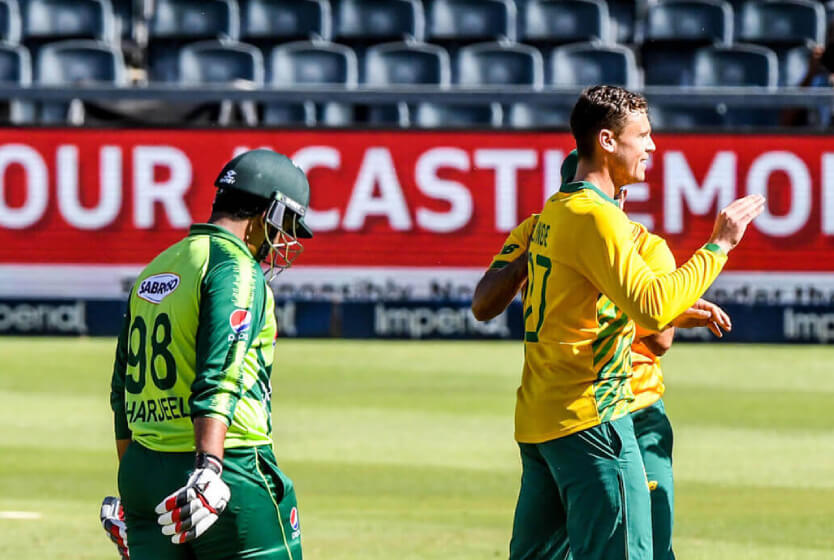
Can Pakistan Overcome Their T20I Batting Shortcomings?
With just a few months remaining for the 2021 T20 World Cup, we look at the problems with Pakistan’s T20I batting.
With not a great deal of time left before the ICC T20 World Cup kickstarts, international teams have begun making final adjustments to their potential battalions. Pakistan, too, seem to have confided in a group of players, boasting senior statesmen and youngsters, who will likely form the team’s core during the mega-event.
The Men in Green have commenced their calendar year on a highly impressive note, winning 7 of the 10 bilateral T20Is they have featured in. However, despite this hot streak under the leadership of Babar Azam, some deep-seated conundrums currently plague Pakistan. These need to be sorted out before they head into the tournament.
Lack of a Top-Order Hitter
Pakistan’s winning streak has coincided and, in many ways, been effectuated by their in-form top-order. Mohammad Rizwan has combined with the skipper Babar Azam to provide Pakistan with consistently decent starts as far as the number of runs accumulated is concerned.
Rizwan’s game has supremely evolved since he has been promoted to the top of the order. Since the start of the year, the wicket-keeper batsman has amassed 530 runs in 10 outings, averaging a staggering 106 runs and striking at just under 142. His partner at the other end, Babar, hasn’t had as good a T20I run recently as he is generally accustomed to. But, working in tandem, the pair has been highly impressive and has contributed heftily to Pakistan’s recent victories.
Looking ahead to the World T20, though, where Pakistan will have to come to grips with more versatile and potent bowling attacks as opposed to the ones they encountered in their recent trip to southern Africa, many people opine that Pakistan are following too conservative an approach at the top.
Firstly, teams’ powerplay data since the start of 2019 suggests that Pakistan have barely utilized the field restrictions to their benefit. Their powerplay run-rate of 7.2 is the worst across the top eight Test-playing nations and does not keep up with modern standards. Additionally, Rizwan and Babar are essentially two anchors. While the former has been exceptionally successful in revamping his playing style to comply with T20 ideals, Babar has not wholly developed the power-striking aspect of his game. The Pakistan captain’s gear-changing problems are well-documented and are usually aggravated on slower surfaces on which hitting through the line is harder.
With the mega-event likely to be shifted to the Emirates, where pitches are on the sluggish side, and the ball keeps lower than usual, Pakistan will be better off slotting in a top-order hitter who can take on different types of bowlers and up the ante. Fakhar Zaman or Sharjeel Khan seem fit for that role, but their numbers in the shortest format of the game since mid-2019 have not been any disparate than the two openers. In fact, Babar and Rizwan have both had better powerplay strike rates and averages than Fakhar and Sharjeel.
Haider Ali, who has been shuffled around the batting card, is another contender keeping in mind his hitting ability against spin-bowling. It’s a must-have expertise for a top-order batsman in the post-powerplay phase. Since 2019, Haider averages a remarkable 60 while facing spin with an even more impressive strike rate of 160. More so, he is yet to be dismissed to spin-bowling in the PSL, which is exhibitive of his prowess against the slower bowlers. Haider can potentially play at number three, where he can not only take on the opposition during the powerplay but also keep the scoreboard ticking along at a decent rate once the restrictions are lifted.
Misfiring Middle-Order
Of late, Pakistan’s middle-order has proved to be an Achilles’ heel despite perpetual experimentation. Barring Mohammad Hafeez, who enjoyed a prolific run of form in 2020 while majorly playing at No 4, none of the middle-order batsmen have quite been able to leave a mark and, consequently, cement their spots.
In order to do away with anchors in the middle-order and try their hand at a more combative middle-order combination, Pakistan have slotted in the likes of Haider Ali, Asif Ali, Khushdil Shah, Danish Aziz, Iftikhar Ahmed, among others. It’s safe to say that nothing has worked to date.
The gravity of the issue at hand is reflected by the fact that the top-three individual scores by Pakistan’s batsmen batting between #5 to #7 since 2020 have been made by Shadab Khan and Faheem Ashraf – two all-rounders who usually bat lower down the order. There is not a single half-century by any of the players who have batted in these three positions within the stipulated span – the highest being Shadab’s 42 in a rescue act in Eden Park six months ago.
A glimpse into the individual numbers of these players solidifies the point that this experimentation from the team management has barely borne any fruit.
- Khushdil has not emulated his National T20 Cup heroics and has not even come close to the promise he showed there.
- The Asif Ali experiment has utterly failed, and he has been unable to string together anything of significance to prove his worth.
- The likes of Shadab and Imad have not brought their all-round capabilities to good effect, pushing Pakistan further down this abyss.
- Even Hafeez’s numbers in 2021 are abysmal – averaging 13.00 in 7 matches with a strike rate of 103.17 – keeping in consideration how otherworldly he looked just in the previous year.
- Haider, who has previously shown genuine promise in the top half of the batting order, was shoved into the middle order, where he has floundered badly. Shifting Haider into the middle-order means that his entry point into the game gets further delayed, as depicted here.
This strengthens the argument established above that Haider is more suited to playing at the top, where he can not only showcase his ball-striking ability but also build a platform for death overs carnage.
If we take a closer look at the averages and strike rates of middle-order batsmen of all teams in the last two years, the atrociously bad performances from Pakistan’s middle-order manifest themselves to their fullest. Pakistan are at par with Bangladesh and Zimbabwe in terms of average while they are the nether-most ranked side in the strike rate column.
Pakistan’s middle-order miseries were brought to the fore in their recent tours of South Africa and Zimbabwe. Pakistan’s batsmen (4-7) scored just 56 runs between them from 9 innings at an appalling combined average of 6.22 runs per player, whereas the middle-order averaged 11.58 in South Africa, which was not any better either.
In Pakistan’s current T20I set-up, there is a dearth of middle-order batsmen who can stroll out into the middle with a bravado-like attitude and take it head-on right from the get-go. However, if we look into the domestic circuit, Azam Khan is highly talked about for traits similar to the ones mentioned above. Azam has this factor of uncanny strength that has bolstered his power-hitting capacity and, subsequently, his utility in the middle-order.
To depict his potential in numbers, Azam has the highest strike rate in T20s for Pakistan players, with a minimum of 500 runs since 2019. The 22-year old’s scoring rate in the middle-overs in this period is also topmost amongst Pakistan batsmen – striking north of 165 with almost 25% of his runs coming through boundaries.
Azam, if utilized properly, can alleviate the conundrums Pakistan currently faces with regards to their middle-order combinations. A detailed piece on Azam’s T20 exploits covers different facets of his game and how he can fit into a struggling Pakistan middle-order.







Leave a Reply